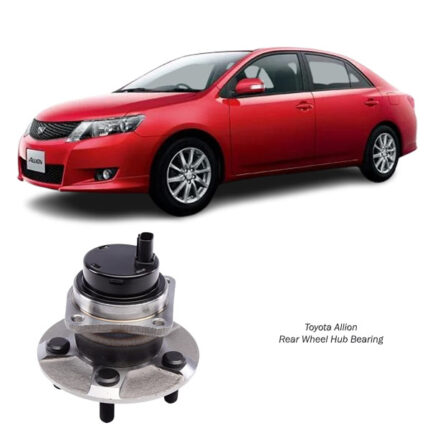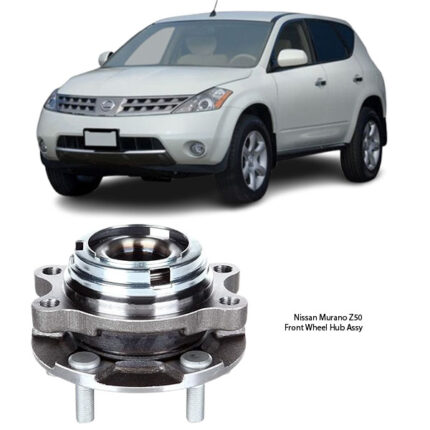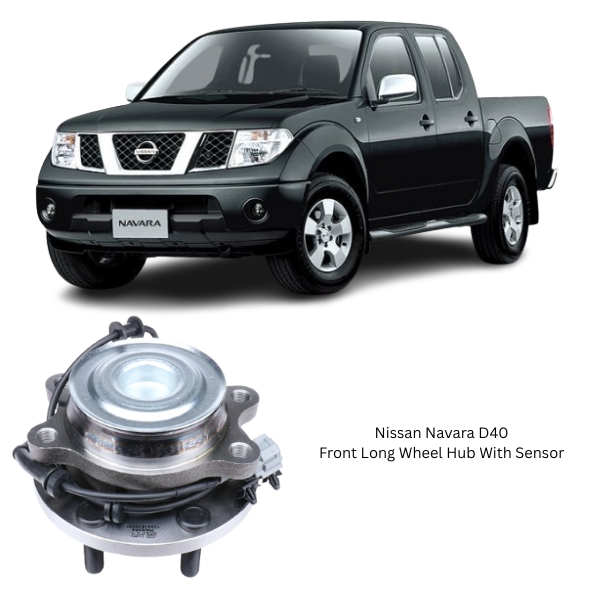Get Nissan Navara D40 Front Long Wheel Hub With Sensor PHU5064 in Kenya
The Front Long Wheel Hub with Sensor is a precision-engineered automotive component that plays a critical role in the integration of wheel rotation, vehicle control, and modern safety systems. Built with a focus on strength, durability, and technological synergy, this hub assembly is designed for vehicles requiring a longer hub body, often due to extended steering knuckle designs, suspension geometries, or load-bearing applications.
Incorporating a wheel speed sensor or tone ring system, the front long wheel hub with sensor supports both mechanical and electronic functionality, making it essential in vehicles equipped with anti-lock braking systems (ABS), electronic stability programs (ESP), and traction control systems (TCS).
Primary Functions
The front long wheel hub with sensor performs a combination of physical and electronic tasks, each vital to proper vehicle operation:
-
Rotational Support: Serves as the central mount for the wheel, enabling smooth and stable rotation.
-
Load Distribution: Transfers the vehicle’s vertical and lateral weight to the suspension and steering components.
-
Sensor Integration: Delivers real-time rotational speed data to the vehicle’s electronic control unit (ECU) via an integrated sensor or magnetic encoder ring.
-
Brake System Integration: Supports brake rotors or discs for efficient braking operations.
-
Steering Responsiveness: Works in harmony with the steering system to maintain precise alignment and control.
Construction and Design
The long wheel hub design is distinguished by an extended central body or spindle, allowing deeper engagement with steering knuckles, larger bearing surfaces, or thicker brake assemblies. This elongation enhances stability, particularly under high-load or off-road conditions.
Key components include:
-
Hub Flange: The outer plate with bolt holes/studs for mounting the wheel. Precision-machined to reduce wobble or misalignment.
-
Extended Shaft Body: The central cylindrical part which penetrates deeper into the steering knuckle or bearing housing, offering improved support and alignment.
-
Pre-Pressed Bearings: Usually a sealed unit, featuring high-strength steel ball or tapered roller bearings designed to endure high radial and axial loads.
-
Integrated Sensor System:
-
Magnetic Encoder Ring: Typically attached to the inner bearing race or rotor, encoding wheel rotation in binary signals.
-
Speed Sensor Slot or Bracket: Accommodates an ABS sensor which reads rotational data and sends it to the vehicle’s ECU.
-
-
Dust Seals & Shields: Protect internal components from moisture, debris, and corrosive road elements.
The hub is typically constructed from forged steel or cast iron, treated with anti-corrosion coatings to extend service life under varied road and weather conditions.
Electronic Sensor Functionality
One of the defining features of this hub is its sensor capability. Integrated into the hub or the bearing assembly, the wheel speed sensor performs the following:
-
Measures Wheel Speed: Monitors how fast each wheel is turning relative to the vehicle’s motion.
-
Feeds Data to the ECU: Communicates with the vehicle’s central control systems.
-
Enables Safety Functions: Supports ABS, traction control, hill assist, and other stability systems.
-
Adaptive Systems Input: Assists in dynamic steering response, torque vectoring, and even automatic emergency braking in modern vehicles.
The sensor system may be active (powered sensor with digital output) or passive (relies on magnetic field interaction), and must maintain strict alignment with the tone ring or encoder.
Applications and Compatibility
The long hub design is typically used in:
-
4×4 and Off-Road Vehicles: Where deeper knuckles or wider track widths demand extended hub shafts.
-
Commercial or Heavy-Duty Vehicles: For handling heavier loads and improving bearing support.
-
Vehicles with Advanced Braking Systems: Where sensor integration is crucial for optimal system feedback.
Its robust architecture allows it to maintain structural integrity under heavy braking, acceleration, and side forces experienced in sharp cornering or rough terrain.
Installation Notes
Proper installation is crucial to ensure the performance, lifespan, and safety of a front long wheel hub with sensor. The process may include:
-
Preparation:
-
Clean all mating surfaces and remove rust or debris from the steering knuckle and rotor surfaces.
-
Inspect and clean the ABS sensor slot or cable if applicable.
-
-
Alignment and Seating:
-
Align the sensor components (encoder ring and sensor probe) precisely to avoid incorrect speed readings or warning lights.
-
Ensure the hub flange sits flush against the rotor and suspension mount.
-
-
Torque and Fastening:
-
Use manufacturer-specified torque values to avoid preload issues in the bearings.
-
If the hub includes a drive spline for CV axles, ensure correct axial engagement with no binding.
-
-
Sensor Testing:
-
Once installed, the sensor system should be tested using diagnostic tools to confirm signal integrity and correct sensor output.
-
Signs of Wear or Failure
Though built for durability, front long wheel hubs with sensors can degrade over time. Common symptoms include:
-
Grinding or Humming Noises: Indicates bearing wear or contamination.
-
ABS Warning Light: Triggered by faulty sensor alignment or failure.
-
Wheel Play or Looseness: May signal worn internal bearing components or mounting issues.
-
Uneven Braking or Steering Pull: Can result from sensor discrepancies or hub misalignment.
-
Noise During Turning: Especially at low speeds, often a sign of internal bearing fatigue.
Failure to address these signs can lead to further suspension and drivetrain damage, or compromised safety.
Maintenance and Longevity
The sealed hub-and-sensor units are designed to be maintenance-free over their operational life. Still, longevity can be affected by:
-
Driving Conditions: Harsh terrain, frequent heavy braking, or off-road usage can accelerate wear.
-
Environmental Exposure: Corrosion from road salt or water ingress can compromise seals and sensor function.
-
Installation Errors: Misalignment or over-torquing can damage internal components or create premature failure.
Expected lifespan can range between 100,000 to 150,000 kilometers, though high-quality variants may last longer with responsible driving and periodic inspections.
Advantages of Using a Long Wheel Hub with Sensor
-
Extended Support: The longer design adds reinforcement and bearing surface area.
-
Sensor-Ready: Built-in accommodations for speed sensors eliminate the need for additional brackets or modifications.
-
Improved Ride Quality: Precision alignment reduces vibration and road noise.
-
Enhanced Safety: Real-time data for ABS and traction systems improves vehicle stability and control.
-
Reduced Downtime: Integrated and sealed components minimize the need for ongoing maintenance or frequent replacements.
Follow us on Facebook for more parts.




